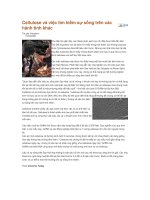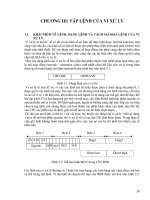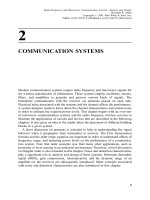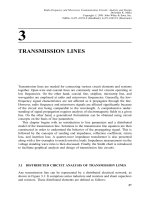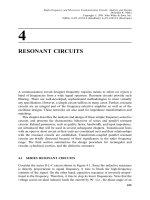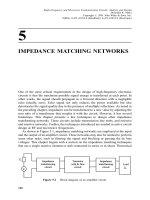Tài liệu RF và mạch lạc lò vi sóng P9 docx
Bạn đang xem bản rút gọn của tài liệu. Xem và tải ngay bản đầy đủ của tài liệu tại đây (257.2 KB, 31 trang )
9
SIGNAL-FLOW GRAPHS AND
APPLICATIONS
A signal-¯ow graph is a graphical means of portraying the relationship among the
variables of a set of linear algebraic equations. S. J. Mason originally introduced it to
represent the cause-and-effect of linear systems. Associated terms are de®ned in this
chapter along with the procedure to draw the signal-¯ow graph for a given set of
algebraic equations. Further,signal-¯ow graphs of microwave networks are obtained
in terms of their S-parameters and associated re¯ection coef®cients. The manipula-
tion of signal-¯ow graphs is summarized to ®nd the desired transfer functions.
Finally,the relations for transducer power gain,available power gain,and operating
power gain are formulated in this chapter.
Consider a linear network that has N input and output ports. It is described by a
set of linear algebraic equations as follows:
V
i
P
N
j1
Z
ij
I
j
i 1; 2; FFF; N 9:1
This says that the effect V
i
at the ith port is a sum of gain times causes at its N ports.
Hence, V
i
represents the dependent variable (effect) while I
j
are the independent
variables (cause). Nodes or junction points of the signal-¯ow graph represent these
variables. The nodes are connected together by line segments called branches with
an arrow on each directed toward the dependent node. Coef®cient Z
ij
is the gain of a
branch that connects the ith dependent node with jth independent node. Signal can
be transmitted through a branch only in the direction of the arrow.
354
Radio-Frequency and Microwave Communication Circuits: Analysis and Design
Devendra K. Misra
Copyright # 2001 John Wiley & Sons,Inc.
ISBNs: 0-471-41253-8 (Hardback); 0-471-22435-9 (Electronic)
Basic properties of the signal-¯ow graph can be summarized as follows:
A signal-¯ow graph can be used only when the given system is linear.
A set of algebraic equations must be in the form of effects as functions of
causes before its signal-¯ow graph can be drawn.
A node is used to represent each variable. Normally,these are arranged from
left to right,following a succession of inputs (causes) and outputs (effects) of
the network.
Nodes are connected together by branches with an arrow directed toward the
dependent node.
Signals travel along the branches only in the direction of the arrows.
Signal I
k
traveling along a branch that connects nodes V
i
and I
k
is multiplied by
the branch-gain Z
ik
. Dependent node (effect) V
i
is equal to the sum of the
branch gain times corresponding independent nodes (causes).
Example 9.1: Output b
1
of a system is caused by two inputs a
1
and a
2
as
represented by the following algebraic equation. Find its signal-¯ow graph.
b
1
S
11
a
1
S
12
a
2
There are two independent variables and one dependent variable in this equation.
Locate these three nodes and then connect node a
1
and a
2
with b
1
,as shown in
Figure 9.1. Arrows on two branches are directed toward effect b
1
. Coef®cients of
input (cause) are shown as the gain of that branch.
Example 9.2: Output b
2
of a system is caused by two inputs a
1
and a
2
as
represented by the following algebraic equation. Find its signal-¯ow graph.
b
2
S
21
a
1
S
22
a
2
There are again two independent variables and one dependent variable in this
equation. Locate these three nodes and then connect node a
1
with b
2
and a
2
with b
2
,
as shown in Figure 9.2. Arrows on two branches are directed toward effect b
2
.
Coef®cients of input (cause) are shown as the gain of that branch.
Figure 9.1 Signal-¯ow graph representation of Example 9.1.
SIGNAL-FLOW GRAPHS AND APPLICATIONS
355
Example 9.3: Input±output characteristics of a two-port network are given by the
following set of linear algebraic equations. Find its signal-¯ow graph.
b
1
S
11
a
1
S
12
a
2
b
2
S
21
a
1
S
22
a
2
There are two independent variables a
1
and a
2
and two dependent variables b
1
and b
2
in this set of equations. Locate these four nodes and then connect node a
1
and
a
2
with b
1
. Similarly,connect a
1
and a
2
with b
2
,as shown in Figure 9.3. Arrows on
the branches are directed toward effects b
1
and b
2
. Coef®cients of each input (cause)
are shown as the gain of that branch.
Example 9.4: The following set of linear algebraic equations represents the input±
output relations of a multiport network. Find the corresponding signal-¯ow graph.
X
1
R
1
1
2 s
X
2
X
2
À4X
1
R
2
À 7Y
1
À
1
s 4
X
2
Y
1
s
s
2
3
X
2
Y
2
10X
1
À sY
1
Figure 9.2 Signal-¯ow graph representation of Example 9.2.
Figure 9.3 Signal-¯ow graph representation of Example 9.3.
356
SIGNAL-FLOW GRAPHS AND APPLICATIONS
In the ®rst equation, R
1
and X
2
represent the causes while X
1
is the effect. Hence,
the signal-¯ow graph representing this equation can be drawn as illustrated in Figure
9.4.
Now,consider the second equation. X
1
is the independent variable in it. Further,
X
2
appears as cause as well as effect. This means that a branch must start and ®nish
at the X
2
node. Hence,when this equation is combined with the ®rst one,the signal-
¯ow graph will look as illustrated in Figure 9.5.
Next,we add to it the signal-¯ow graph of the third equation. It has Y
1
as the
effect and X
2
as the cause. It is depicted in Figure 9.6.
Figure 9.4 Signal-¯ow graph representation of the ®rst equation of Example 9.4.
Figure 9.5 Signal-¯ow graph representation of the ®rst two equations of Example 9.4.
Figure 9.6 Signal-¯ow graph representation of the ®rst three equations of Example 9.4.
SIGNAL-FLOW GRAPHS AND APPLICATIONS
357
Finally,the last equation has Y
2
as a dependent variable,and X
1
and Y
1
are two
independent variables. A complete signal-¯ow graph representation is obtained after
superimposing it as shown in Figure 9.7.
9.1 DEFINITIONS AND MANIPULATION OF SIGNAL-FLOW GRAPHS
Before we proceed with manipulation of signal-¯ow graphs,it will be useful to
de®ne a few remaining terms.
Input and Output Nodes: A node that has only outgoing branches is de®ned as an
input node or source. Similarly,an output node or sink has only incoming branches.
For example, R
1
, R
2
,and Y
1
are the input nodes in the signal-¯ow graph shown in
Figure 9.8. This corresponds to the ®rst two equations of Example 9.4. There is no
output node (exclude the dotted branches) in it because X
1
and X
2
have both
Figure 9.7 Complete signal-¯ow graph representation of Example 9.4.
Figure 9.8 Signal-¯ow graph with R
1
, R
2
,and Y
1
as input nodes.
358
SIGNAL-FLOW GRAPHS AND APPLICATIONS
outgoing as well as incoming branches.
Nodes X
1
and X
2
in Figure 9.8 can be made the output nodes by adding an
outgoing branch of unity gain to each one. This is illustrated in Figure 9.8 with
dotted branches. It is equivalent to adding X
1
X
1
and X
2
X
2
in the original set of
equations. Thus,any non-output node can be made an output node in this way.
However,this procedure cannot be used to convert these nodes to input nodes
because that changes the equations. If an incoming branch of unity gain is added to
node X
1
then the corresponding equation is modi®ed as follows:
X
1
X
1
R
1
1
2 s
X
2
However, X
1
can be made an input node by rearranging it as follows. The
corresponding signal-¯ow graph is illustrated in Figure 9.9. It may be noted that now
R
1
is an output node:
R
1
X
1
À
1
2 s
X
2
Path: A continuous succession of branches traversed in the same direction is called
the path. It is known as a forward path if it starts at an input node and ends at an
output node without hitting a node more than once. The product of branch gains
along a path is de®ned as the path gain. For example,there are two forward paths
between nodes X
1
and R
1
in Figure 9.9. One of these forward paths is just one
branch connecting the two nodes with path gain of 1. The other forward path is X
1
to
X
2
to R
1
. Its path gain is 4=2 s.
Loop: A loop is a path that originates and ends at the same node without
encountering other nodes more than once along its traverse. When a branch
originates and terminates at the same node,it is called a self-loop. The path gain
of a loop is de®ned as the loop gain.
Figure 9.9 Signal-¯ow graph with R
1
as an output,and X
1
, R
2
,and Y
1
as the input nodes.
DEFINITIONS AND MANIPULATION OF SIGNAL-FLOW GRAPHS
359
Once the signal-¯ow graph is drawn,the ratio of an output to input node (while
other inputs,if there are more than one,are assumed to be zero) can be obtained by
using rules of reduction. Alternatively, Mason's rule may be used. However,the
latter rule is prone to errors if the signal-¯ow graph is too complex. The reduction
rules are generally recommended for such cases,and are given as follows.
Rule 1: When there is only one incoming and one outgoing branch at a node (i.e.,
two branches are connected in series),it can be replaced by a direct branch with
branch gain equal to the product of the two. This is illustrated in Figure 9.10.
Rule 2: Two or more parallel paths connecting two nodes can be merged into a
single path with a gain that is equal to the sum of the original path gains,as depicted
in Figure 9.11.
Rule 3: A self-loop of gain G at a node can be eliminated by multiplying its input
branches by 1=1 À G. This is shown graphically in Figure 9.12.
Rule 4: A node that has one output and two or more input branches can be split in
such a way that each node has just one input and one output branch,as shown in
Figure 9.13.
Figure 9.10 Graphical illustration of Rule 1.
Figure 9.12 Graphical illustration of Rule 3.
Figure 9.11 Graphical illustration of Rule 2.
360
SIGNAL-FLOW GRAPHS AND APPLICATIONS
Rule 5: It is similar to Rule 4. A node that has one input and two or more output
branches can be split in such a way that each node has just one input and one output
branch. This is shown in Figure 9.14.
Mason's Gain Rule: Ratio T of the effect (output) to that of the cause (input) can be
found using Mason's rule as follows:
Ts
P
1
Á
1
P
2
Á
2
P
3
Á
3
ÁÁÁ
Á
9:1:1
where P
i
is the gain of the ith forward path,
Á 1 À
P
L1
P
L2À
P
L3ÁÁÁ 9:1:2
Á
1
1 À
P
L1
1
P
L2
1
À
P
L3
1
ÁÁÁ 9:1:3
Á
2
1 À
P
L1
2
P
L2
2
À
P
L3
2
ÁÁÁ 9:1:4
Á
3
1 À
P
L1
3
ÁÁÁ 9:1:5
F
F
F
P
L1 stands for the sum of all ®rst-order loop gains;
P
L2 is the sum of all
second-order loop gains,and so on.
P
L1
1
denotes the sum of those ®rst-order
loop gains that do not touch path P
1
at any node;
P
L2
1
denotes the sum of those
Figure 9.13 Graphical illustration of Rule 4.
Figure 9.14 Graphical illustration of Rule 5.
DEFINITIONS AND MANIPULATION OF SIGNAL-FLOW GRAPHS
361
second-order loop gains that do not touch the path of P
1
at any point;
P
L1
2
consequently denotes the sum of those ®rst-order loops that do not touch path P
2
at
any point,and so on.
First-order loop gain was de®ned earlier. Second-order loop gain is the product of
two ®rst-order loops that do not touch at any point. Similarly,third-order loop gain is
the product of three ®rst-order loops that do not touch at any point.
Example 9.5: A signal-¯ow graph of a two-port network is given in Figure 9.15.
Using Mason's rule,®nd its transfer function Y =R.
There are three forward paths from node R to node Y . Corresponding path gains
are found as follows:
P
1
1 ? 1 ?
1
s 1
? 1 ?
s
s 2
? 3 ? 1
3s
s 1s 2
P
2
1 ? 6 ? 1 6
and,
P
3
1 ? 1 ?
1
s 1
? À4 ? 1 À
4
s 1
Next,it has two loops. The loop gains are
L
1
À
3
s 1
and,
L
2
À
5s
s 2
Using Mason's rule,we ®nd that
Y
R
P
1
P
2
1 À L
1
À L
2
L
1
L
2
P
3
1 À L
2
1 À L
1
À L
2
L
1
L
2
Figure 9.15 Signal-¯ow graph of Example 9.5.
362
SIGNAL-FLOW GRAPHS AND APPLICATIONS
9.2 SIGNAL-FLOW GRAPH REPRESENTATION OF A VOLTAGE
SOURCE
Consider an ideal voltage source E
S
0
in series with source impedance Z
S
,as
shown in Figure 9.16. It is a single-port network with terminal voltage and current
V
S
and I
S
,respectively. It is to be noted that the direction of current-¯ow is assumed
as entering the port,consistent with that of the two-port networks considered earlier.
Further,the incident and re¯ected waves at this port are assumed to be a
S
and b
S
,
respectively. Characteristic impedance at the port is assumed to be Z
o
.
Using the usual circuit analysis procedure,total terminal voltage V
S
can be found
as follows:
V
S
V
in
S
V
ref
S
E
S
Z
S
I
S
E
S
Z
S
I
in
S
I
ref
S
E
S
Z
S
V
in
S
À V
ref
S
Z
o
9:2:1
where superscripts ``in'' and ``ref'' on V
S
and I
S
are used to indicate the
corresponding incident and re¯ected quantities. This equation can be rearranged
as follows:
1
Z
S
Z
o
V
ref
S
E
S
À 1À
Z
S
Z
o
V
in
S
or,
V
ref
S
Z
o
Z
o
Z
S
E
S
À
Z
o
À Z
S
Z
o
Z
S
V
in
S
Dividing it by
2Z
o
p
,we ®nd that
V
ref
S
2Z
o
p
Z
o
Z
o
Z
S
E
S
2Z
o
p
À
Z
o
À Z
S
Z
o
Z
S
V
in
S
2Z
o
p
Figure 9.16 Incident and re¯ected waves at the output port of a voltage source.
SIGNAL-FLOW GRAPH REPRESENTATION OF A VOLTAGE SOURCE
363
Using (7.6.15) and (7.6.16),this can be written as follows:
b
S
b
G
À
S
a
S
9:2:2
where,
b
S
V
ref
S
2Z
o
p
9:2:3
b
G
Z
o
p
E
S
2
p
Z
o
Z
S
9:2:4
a
S
V
in
S
2Z
o
p
9:2:5
and,
À
S
Z
S
À Z
o
Z
S
Z
o
9:2:5
From (9.2.2),the signal ¯ow graph for a voltage source can be drawn as shown in
Figure 9.17.
9.3 SIGNAL-FLOW GRAPH REPRESENTATION OF A PASSIVE
SINGLE-PORT DEVICE
Consider load impedance Z
L
as shown in Figure 9.18. It is a single-port device with
port voltage and current V
L
and I
L
,respectively. The incident and re¯ected waves at
the port are assumed to be a
L
and b
L
,respectively. Further,characteristic impedance
at the port is Z
o
.
Following the usual circuit analysis rules,we ®nd that
V
L
V
in
L
V
ref
L
Z
L
I
L
Z
L
I
in
L
I
ref
L
Z
L
V
in
L
À V
ref
L
Z
o
Figure 9.17 Signal-¯ow graph representation for a voltage source.
364
SIGNAL-FLOW GRAPHS AND APPLICATIONS
or,
1
Z
L
Z
o
V
ref
L
Z
L
Z
o
À 1
V
in
L
9:3:1
or,
V
ref
L
Z
L
À Z
o
Z
L
Z
o
V
in
L
À
L
V
in
L
9:3:2
After dividing it by
2Z
o
p
,we then use (7.6.15) and (7.6.16) to ®nd that
b
L
À
L
a
L
9:3:3
where,
b
L
V
ref
L
2Z
o
p
9:3:4
a
L
V
in
L
2Z
o
p
9:3:5
and,
À
L
Z
L
À Z
o
Z
L
Z
o
9:3:6
A signal-¯ow graph can be drawn on the basis of (9.3.3),as shown in Figure 9.19.
Example 9.6: Impedance Z
L
terminates port-2 (output) of a two-port network as
shown below in Figure 9.20. Draw the signal-¯ow graph and determine the re¯ection
coef®cient at its input port using Mason's rule.
Figure 9.18 A passive one-port circuit.
SIGNAL-FLOW GRAPH REPRESENTATION OF A PASSIVE
365
